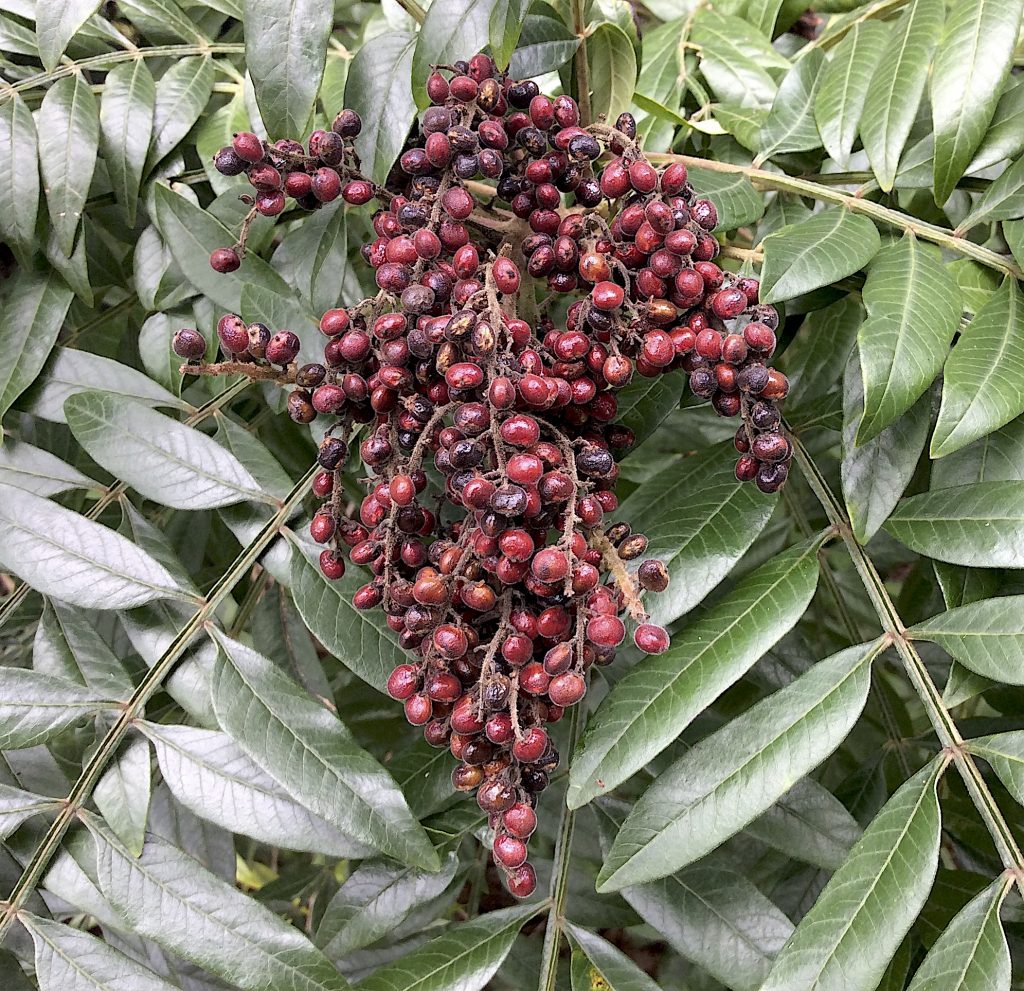
Winged Sumac. The berries are tart like an apple. Photo by Green Deane
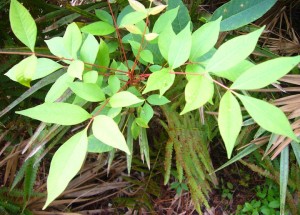
Poison Sumac. Note the red stems. Photo by Green Deane
Our Sumacs are happy. Everywhere you go now they are sporting terminal clusters of garnet-colored berries. It is time to harvest Sumacs for use today or later. There’s a wide variety of Sumacs. Locally it’s the “Wing Sumac.” In other areas of the country it can be the Staghorn Sumac. Shapes and quality vary but they always have terminal clusters of garnet-colored berries, give or take a hue. The berries have hair on them. And on the hair is malic acid, the acid that makes apples tart. You can rinse off the acid and make a vitamin-C rich “lemonade.” The berries can then be dried, ground, and used as a spice. And in the springs the shoots can be peeled and eaten raw or cooked. If you are worried about Poison Sumac, to the upper right, it grows only in wet spots, has a much different leaf, and when in fruit has white berries positioned farther down the stem, not terminal clusters. Also Poison Sumac leaves have bright red stems.
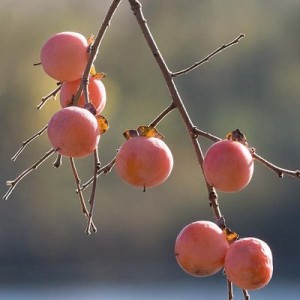 Besides the aforementioned Sumac what you should also be finding now — depending on where you live — are Persimmons and Saw Palmetto berries, just about the opposite on the flavor scale, sublime to you-gotta-be-kidding-me. Saw Palmetto berries ripen about mid-September but stay around for a month or more. They are stong flavored, try only a little. I had a ripe persimmon a month ago in Orlando but they are more an early October fruit locally. I saw some in Jacksonville this past weekend that were almost ripe. As for other seasonal forageables in Melbourne we found several vines with ripe Creeping Cucumbers.
Besides the aforementioned Sumac what you should also be finding now — depending on where you live — are Persimmons and Saw Palmetto berries, just about the opposite on the flavor scale, sublime to you-gotta-be-kidding-me. Saw Palmetto berries ripen about mid-September but stay around for a month or more. They are stong flavored, try only a little. I had a ripe persimmon a month ago in Orlando but they are more an early October fruit locally. I saw some in Jacksonville this past weekend that were almost ripe. As for other seasonal forageables in Melbourne we found several vines with ripe Creeping Cucumbers.
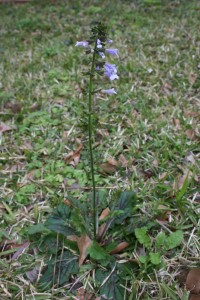
Lyre-Leaf Sage. Photo by Green Deane
In his book Edible Plants of North America, Francois Couplan writes on page 384: “the leaves of the S. lyrata, Eastern North America, contain an acrid principle and should not be ingested. They have been used to remove warts.” That said I know an herbalist who makes a tea from the leaves and a foraging instructor who cooks the young leaves and eats them. I’ve heard other reports of them being eaten. That can leave a person in a tough spot as to what to do with the plant. To eat or not to eat, that is the question.
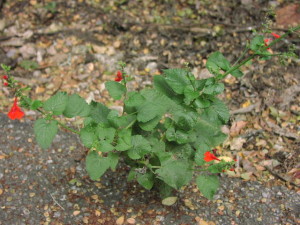
Tropical Sage. Photo by Green Deane
Another example is also a sage, Salvia coccinea, also known as Tropical Sage. A small piece of the blossom of this species — a very tiny piece, 1/8 inch square — made me horribly sick for several weeks. It attacked my stomach with viciousness and I was go-to-the-emergency room miserable. Coca-cola syrup and Pepto-Bismol combined were my salvation from doubled-over pain. I was actually “field testing” this plant for edibility at the time, one reason why I am very opposed to field testing. Yet, I know of two people who have eaten the young leaves with no problem. Perhaps it was a personal allergy on my part. I don’t know. But I do know I will never eat any part of that plant again. Ever. Lesson painfully learned. Yet it might be edible, or maybe some folks really do have cast iron stomachs. I know I don’t. Eating this sage is one of those “you’re on your own” kind of things.
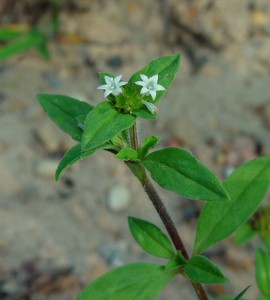
Richardia is generally not edible.
A third plant that falls into the crack between edible and not edible is Richardia scabra, aka Florida Pusley. It is in a genus that has species used to make you throw up. In fact one is called Richardia emetica. That is not encouraging. Some people mistake R. scabra for chickweed, which is a Stellaria, a totally different genus. The plants vaguely resemble each other if one ignores several details and that fact that real chickweed only grows here in the winter time. R. scabra is a species for which I have never found any ethnobotanical references to regarding edibility. In fact it is one of three common plants that seems to have either not been used by the natives or somehow were not reported. The other two are Amaranthus australis and Hibiscus moscheutos. I know from modern reports that A. australis is edible but as for the H. moscheutos I have no idea though it comes from a very edible genus. Thus R. scabra is not on my site as an edible because I can’t find any historical reference to its use. Yet I know two people who mistook it for chickweed and ate it for quite a while. And I know two people who did not mistake it; they know it is a Richardia and they eat it from time to time. That might be a key element. Without any ethnobotanical reference perhaps a little now and then is okay but a steady diet of it is not. It is one of those unknown things.
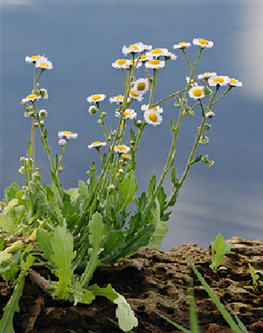
Oakleaf Flea Bane, good for pets’ beds.
Sometimes eating little bits of this or that do not rise to the level of making you ill. Other times it can make you quite sick like me and the Tropical Sage above. I know a person who mistook Oak Leaf Fleabane (Erigeron quercifolius) for for Plantago major and ate some for quite a while without an apparent problem. That tells us that perhaps there is not acute toxicity (read quick) but who knows what harm it might do long term. I have personally seen someone eat a leaf of Oak Leaf Fleabane against my advice. She was still standing at the end of class. So there are definitely edible plants, and there are definitely non-edible plants. But there can be some fog in between. I have also seen an herbalism teacher eat one Mistletoe leaf and white berry.

Classes are held rain or shine or cold.
Foraging Classes: A bit of travel this weekend. One foraging class in Sarasota and one in Orlando.
Saturday, October 20th, Red Bug Slough Preserve, 5200 Beneva Road, Sarasota. 9 a.m. to noon. THIS CLASS IS CANCELLED AND WILL BE RESCHEDULED.
Sunday, October 21st, Blanchard Park, 10501 Jay Blanchard Trail, Orlando. 9 a.m. to noon.
Saturday, October 27th, George LeStrange Preserve, 4911 Ralls Road, Fort Pierce, FL, 34981. 9 a.m. to noon.
Sunday, October 28th, Dreher Park, 1200 Southern Blvd., West Palm Beach, 33405. 9 a.m. to noon. Meet just north of the science center, north section of the park.
Sunday, November 3rd, Bayshore Live Oak Park, Bayshore Drive. Port Charlotte, 9 a.m. to noon. Meet at the parking lot of Ganyard Street and Bayshore Road.
November 4th Blanchard Park, 10501 Jay Blanchard Trail, Orlando. 9 a.m. to noon. Don’t forget the clock turned back an hour last night.
November 10th, Boulware Springs Park, 3420 SE 15th St., Gainesville, FL 32641. 9 a.m. to noon.
To read more about the foraging classes or to sign up go here.
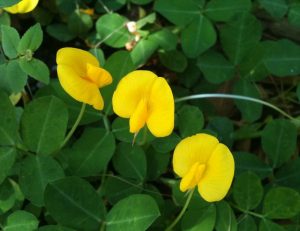
Perennial Peanut. The blossoms are edible.
I learned of this edible blossom from a chef who told me she ate them. That got my attention. Arachis glabrata, which botanists call by the spiffy name of Rhizoma Peanut, is also called Rhizomal Perennial Peanut, Perennial Forage Peanut, Golden Glory, and Ornamental Peanut Grass… none of them really catchy. It’s related closely to the peanut we eat, Arachis hypogaea (which by the way has edible stems and leaves, raw or cooked.) My first reference of choice, Cornucopia II, had nothing on the “Perennial Peanut” nor did my trusty standby, the Journal of Economic Botany. On-line, where I am loathe to do research unless absolutely necessary, I turned up little. It is grazing fodder native to Brazil. No mentions in English of humans eating it. But I did find a study in which researchers fed leaf powder to hens to see if it increased the intensity of yoke color. That can go both ways. It would seem reasonable they would not feed something toxic to hens for a product humans eat but they do exactly that with arsenic. That chemical is a disease preventative in chickens. So feeding hens Perennial Peanut leaf powder was no sign it was edible by humans. Finding no good sources I did what I have done many times in the compilation of this site: I wrote to one of the foraging study researchers, Benjamin Anderson, asking if he knew if humans could eat the plant. He wrote back.
“Yes, I know that a lot of people eat the blossoms and they actually taste like peanuts. I have even heard of them being used in salads. Just be careful eating anything where there may have been chemicals sprayed, though.” I would add yellow blossoms eaten in quantities also tend to be a laxative.
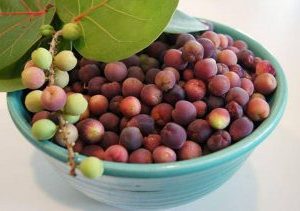 In and almost out of season depending where you are now is Sea-grapes. In south Florida there were still a few left on the trees (and quite a few if you don’t mind battling the ants on the ground.) Like persimmons, which are also in season, grounded Sea-grapes can be sweet, if not slightly fermented. And what a difference 200 miles can make. In the center of the state Sea-grapes make a shrub barely taller than six or seven feet. In south Florida they are tall trees. Also on the seasonal wane are coco-plums. All we found were a few white ones, the other color varieties were fruitless. But we did manage to see some late season (who knows now, maybe early season) Simpson Stopper berries. On the marmalade side they might be an acquired taste. And to top out the seasonal dance some Poor Man’s Peppergrass was sprouting anew. While it technically grows all year here it heavily favors the winter and spring. Again, two months ahead of time. It might be an unusual winter, and spring.
In and almost out of season depending where you are now is Sea-grapes. In south Florida there were still a few left on the trees (and quite a few if you don’t mind battling the ants on the ground.) Like persimmons, which are also in season, grounded Sea-grapes can be sweet, if not slightly fermented. And what a difference 200 miles can make. In the center of the state Sea-grapes make a shrub barely taller than six or seven feet. In south Florida they are tall trees. Also on the seasonal wane are coco-plums. All we found were a few white ones, the other color varieties were fruitless. But we did manage to see some late season (who knows now, maybe early season) Simpson Stopper berries. On the marmalade side they might be an acquired taste. And to top out the seasonal dance some Poor Man’s Peppergrass was sprouting anew. While it technically grows all year here it heavily favors the winter and spring. Again, two months ahead of time. It might be an unusual winter, and spring.
 Donations to upgrade EatTheWeeds.com and fund a book have gone well and made it past the half way mark. Thank you to all who have contributed to either via the Go Fund Me link, the PayPal donation link or by writing to Green Deane POB 941793 Maitland FL, 32794. There are many needs left such as expanding the foraging teacher page and the page on monotypic edibles. Several functions were also lost when we transitioned to the new website. There’s always something and such things get more complex and expensive every year.
Donations to upgrade EatTheWeeds.com and fund a book have gone well and made it past the half way mark. Thank you to all who have contributed to either via the Go Fund Me link, the PayPal donation link or by writing to Green Deane POB 941793 Maitland FL, 32794. There are many needs left such as expanding the foraging teacher page and the page on monotypic edibles. Several functions were also lost when we transitioned to the new website. There’s always something and such things get more complex and expensive every year.

Green Deane Forum
Want to identify a plant? Need to identify a plant? Looking for a foraging reference? Maybe you have a UFO, an Unidentified Flowering Object, you want identified. On the Green Deane Forum we — including Green Deane — chat about foraging all year. And it’s not just about warm-weather plants or just North American flora. Many nations share common weeds so there’s a lot to talk about. There’s also more than weeds. The reference section has information for foraging around the world. There are articles on food preservation, and forgotten skills from making bows to fermenting food. Recent topics include: I Finally Found Wapato, Looks like Corn, Weed With Pod At Top, A Mile Walk In The Woods, Chicken of the Woods?, Elderberry Fungus, Spurge Nettle 2018, Does Anybody Know This Berry, and Five-Minute “English” Muffin with Beautyberries. You can join the forum by clicking on the button in the menu line.

Green Deane DVD set of 135 videos
All of Green Deane’s videos are available for free on You Tube. They do have ads on them so every time you watch a Green Deane video I get a quarter of one cent. Four views, one cent. Not exactly a large money-maker but it helps pays for this newsletter. If you want to see the videos without ads and some in slightly better quality you can order the DVD set. It is nine DVDs with 15 videos on each for a total of 135 videos. Many people want their own copy of the videos or they have a slow service and its easier to order then to watch them on-line. The DVDs make a good gift for that forager you know especially on long, cold winter months. Individual DVDs can also be ordered or you can pick and choose. You can order them by clicking on the button on the top right hand side of this page (if your window is open wide enough.) Or you can go here.
This is weekly issue 326.
If you would like to donate to Eat The Weeds please click here. Or you can use my Go Fund Me link, or by writing to Green Deane POB 941793 Maitland FL, 32794


My family has harvested and used Lyre-leaf sage for years. Young and “old”. It has been a beloved plant at our house. The Cherokee made it into a tea and added a vinegar which I do usually using a balsamic vinegar mixed with honey. The tea, when taken at the first inclination of a cold or flu etc has always threw off the symptoms and cured us. If on the other hand, we didn’t take the tea till a day or two into the symptoms then it reduces the negative effects of flu cold etc making it easy to go about our business. We do eat it but because it is so good at curing sickness, the majority of my harvest is kept in my herbal remedy cabinet. Strangely, we have noticed that the few leaves that grow on the flower stem are most effective for healing and curing. The leaves at the base of the plant are also effective; but for some reason, the ones on the flower stem exceed them. We usually eat the leaves at the base and save the upper leaves for our herbal remedy cabinet.